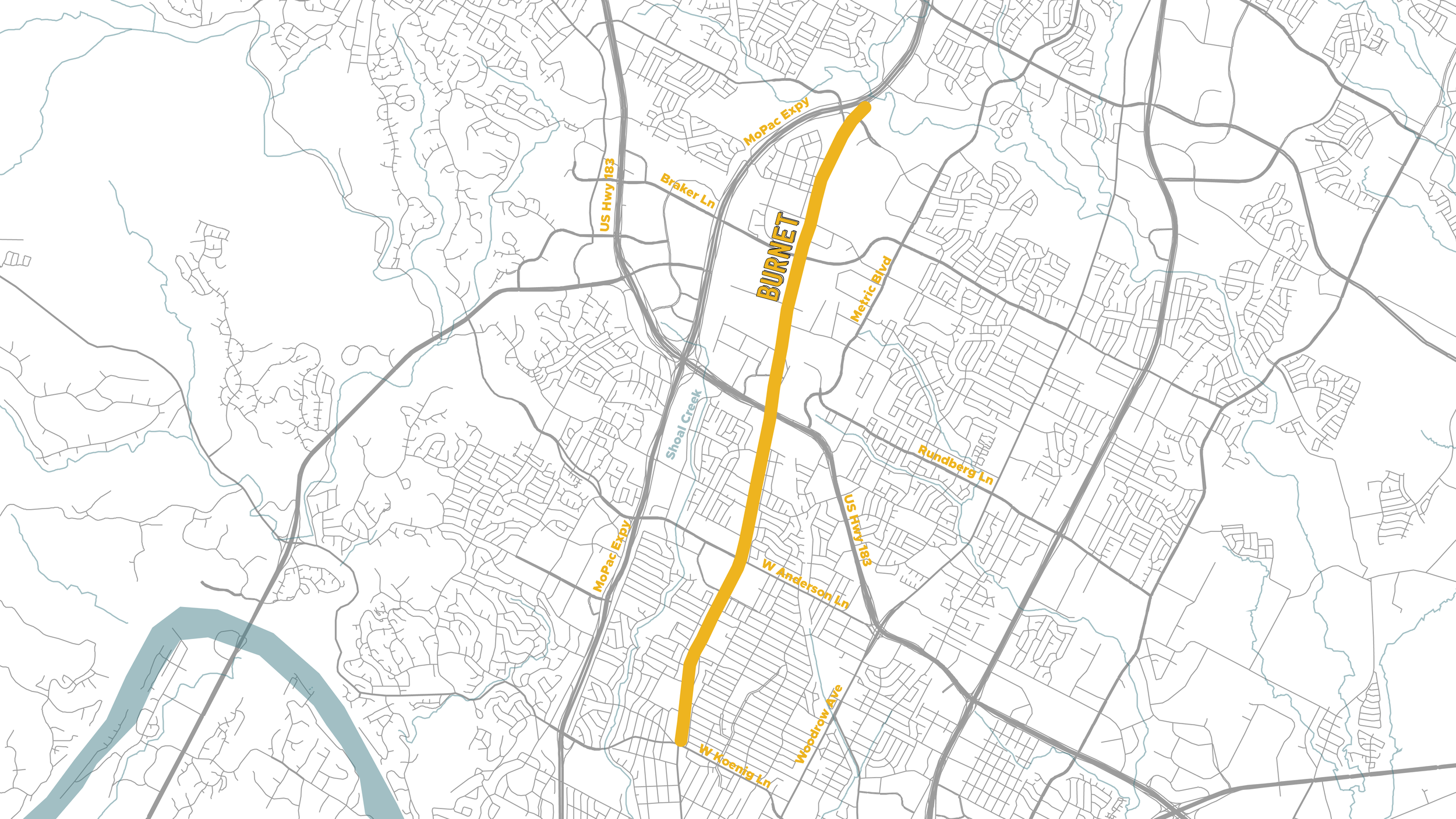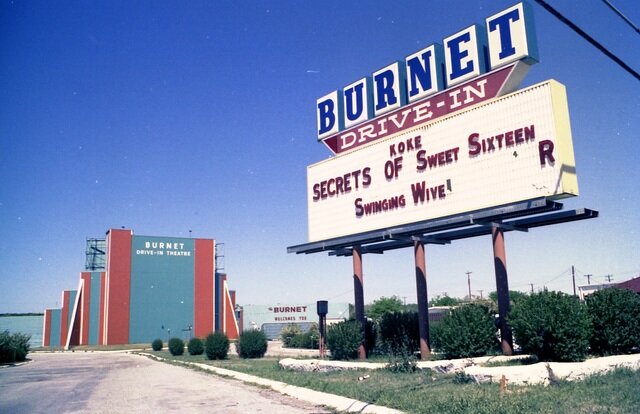Burnet Road
Burnet Road is a mainstay of Austin culture. The 5-mile corridor provides access to businesses, shopping centers, restaurants, neighborhoods, and mixed-use developments. The surrounding community relies on Burnet Road to connect to work, school, recreation, and entertainment, making it a vital corridor in our City.
———————————————————————————————
Burnet Road es un pilar de la cultura de Austin. El corredor de 5 millas brinda acceso a negocios, centros comerciales, restaurantes, vecindarios y desarrollos de uso mixto. La comunidad circundante depende de Burnet Road para conectarse con el trabajo, la escuela, la recreación y el entretenimiento, lo que la convierte en un corredor vital en nuestra ciudad.
The original HEB location in Allandale Village. Source: Google Maps
History
The corridor along Burnet Road is on the traditional and ancestral homelands of the Tonkawa, the Apache, the Ysleta del sur Pueblo, the Lipan Apache Tribe, the Texas Band of Yaqui Indians, the Coahuitlecan and all other tribes not explicitly stated. Additionally, we would like to acknowledge and pay respects to the many other tribes, Indigenous Peoples, and communities who have been or have become a part of these lands and territories now known as Texas.
The original purpose of Burnet Road (formerly Upper Georgetown Road) was to connect farmers to town and to keep Austin and Georgetown connected. The road, previously serving as a city limit.
Upper Georgetown Road in 1947 looking north, near today’s Justin Lane. Source: Susan Burneson/Voices of the Violet Crown
In the 1930s and 1940s, the Rosedale and Brentwood neighborhoods appeared as the first subdivisions along Burnet Road. Growth and development continued to spread in the late 1940s, after World War II, which was when the Crestview and Allandale neighborhoods began to be built.
Several men constructing a telephone or power pole in the Crestview neighborhood in 1952. The sign reads: “Crestview Large Lots, $595.” Several structures in the background appear to be part of the old Richcreek Dairy Farm where the Crestview neighborhood was built. Source: PICA 26748, Austin History Center, Austin Public Library
As more residents moved to the area, businesses began to pop up to conveniently provide access to local goods and foods for the community. Gas stations, grocery stores, and automobile services became more accessible and connected people to the goods and services they needed most.
Allandale Village and the original HEB Grocery Store in 1950. Source: Image 50-A127-01, Neal Douglass Collection, Austin History Center, Austin Public LIbrary
As one of the Travis County rural schools, the Esperanza School was on the northeast corner of today’s Burnet Road and Romeria Drive from 1893 to 1941. It provided education to children who lived on nearby farms then outside the Austin city limits. Originally a one-room school, it was expanded to two rooms in 1922 with 40 students, and to three rooms in 1934. By the 1950s, new city schools — including Brentwood Elementary School, Lamar Middle School, and McCallum High School - were built to educate children living in the quickly growing Allandale, Brentwood, and Crestview neighborhoods bordering Burnet Road.
Esperanza School. Sources: Susan Burneson/Voices of the Violet Crown
Rubin and Elizabeth Hancock were among the first generation of freed slaves to purchase and farm their own land in Travis County after the Civil War. They helped establish the community of Duval, a small but thriving community of African-American farmers. Rubin Hancock, his three brothers, and other family members were slaves of Judge Hancock prior to their emancipation. The family is buried at St. Paul Baptist Church Cemetery on Ohlen Road.
Map of roads in north-central Travis County, 1898-1902, retraced in 1915, showing schools and land owners (project area, including Rubin Hancock farmstead, is shaded). Source: Texas History and Beyond and map Courtesy of the Austin History Center.
Life on the Corridor
Listen to Bill Thompson for the proper pronunciation of “Burnet”.
“Burnet Road was and I hope will continue to be a time capsule back to old Austin.”
Annie Hartnett
Burnet Drive-in (today’s Burnet Road Storage), was one of four drive-in movies built in the area in the 1940s and 1950s. Others were Eddie Joseph’s North Austin, North Lamar at Justin Lane; the Chief, North Lamar at Koenig; and the Longhorn, on Anderson Lane. Source: Cinema Treasures
“Original neighbors in Brentwood and Crestview included World War II veterans and their families and others looking for homes that were reasonably priced and conveniently located. Their lives and the homes they built were fairly modest, but they established a strong community where neighbors are willing to help each other. They became involved in churches, schools, the park, and other community activities, and they sustained that involvement over many years. What I noticed when I began researching neighborhood history in 2003 is that new people moving here also valued being good neighbors. That same spirit continues today.”
Susan Burneson
St. Louis King of France Catholic Church choir rehearsal. Source: ATX Barrio Archive
Listen to Nancy Barnard share about the Violet Crown Festival and introduce the tradition of Domino the pig, the neighborhood mascot, and watch the short film, First Night W/ Domino & Friends.
Domino at a recent Violet Crown Festival and 2006 film made by Susan and Rob Burneson. Sources: Jennifer M. Ramos and Susan Burneson/Voices of the Violet Crown
“There's a myriad of little shops from vacuum cleaner repairs to clock repairs to things that the majority of the city wouldn't deem relevant. But I have a vacuum cleaner, and I get it repaired there. There are those of us who still use local businesses and don’t do everything online.”
Kelly Chappell
Top Drawer Thrift. Source: The Austin Common.
“We can be found at happy hour at Lala's, where it is Christmas every day, two stepping at
Ginny’s Little Longhorn Saloon
and playing chicken Sh*t bingo on Sundays, and grabbing a 6 pack at Arlan's and a pizza from Little Deli on Thursdays for date night. You can see live music at Ginny's almost any night and always run into someone you know.”
Lisa Boone
Ginny’s Little Longhorn. Source: The Little Longhorn Saloon.
Listen to Kelly Chappell tell the history of the Austin favorite, Top Notch and the evolution of Burnet Road over generations.
Top Notch in full swing. Source: 365thingsaustin.com
Listen to Bill Thompson, former owner of the Dallas Nightclub share about "the greatest dancehall in Austin” on Burnet Road.
The Dallas Nightclub. Source: Dan B./Yelp
Burnet Road is known for many iconic restaurants, like the Frisco, the last of the Night Hawk family of restaurants in Austin. Founder Harry Akin was one of the first restaurateurs in Austin to hire minorities and women, in the 1930s, and to desegregate the restaurant and serve black customers, in 1959, five years before the Civil Rights Act made it mandatory throughout the U. S. The Frisco, which originally opened in 1953 at another location on Burnet Road, closed in 2018. It now lives on through the memories and stories of those who ate and worked there.
The Frisco’s on its 60th anniversary. Source: The Frisco/Facebook.
“He’s like the mascot for Burnet Road. I would never want to see
that building get taken away.”
Gabi Kane
The iconic Light Bulb Shop sign. Read “Light Bulb Shop to go dark after nearly 40 years” Source: The Light Bulb Shop.
“The most popular piece of art in the five square miles around where I live in the Brentwood is a community-based project. I have a tile on the wall. Most of my neighbors and friends that have been around for years have a tile on the wall.”
Kelly Chappell
The mosaic Wall of Welcome was created by Brentwood artist Jean Graham, with the help of hundreds of neighbors. It faces Woodrow Avenue near Crestview Shopping Center. The Violet Crown Festival and a nonprofit, Violet Crown Community Works, were established to help raise funds for the project, which was completed in 2008. Today, the festival and nonprofit continue to support neighborhood enhancement projects in Brentwood and Crestview. Source: Susan Burneson/ Voices of the Violet Crown.
The current owner of the Moore-Hancock Homestead, Karen Collins created a map in 1993, that encouraged her neighbors to take a self-guided walk, called Rosedale Rambles to learn about the history of the homes and buildings in the area.
Source: Karen Sikes Collins, Susan Burneson/Voices of the Violet Crown
“Brentwood and Crestview had few trees when the two neighborhoods were
established. For more than 70 years, neighbors—individually and in
groups—have helped plant and maintain trees in the park and throughout the neighborhood.Emily Wilson, who helped found Friends of Brentwood Park, an active park adoption group, said it best: ‘Somebody before us planted these trees, and it’s up to us to do the same, so there will be trees here for the next generation.’”
Susan Burneson
The film We Planted 115 Trees was produced by Susan and Rob Burneson in 2010. Source: Susan Burneson/Voices of the Violet Crown
“
flows through four neighborhoods that border Burnet Road—Crestview, Brentwood, Allandale, and Rosedale, where it joins Shoal Creek. In Crestview and Brentwood, it’s sometimes called Arroyo Seco, the name of the street on either side of it. The creek was named for John Hancock, an Austin judge and legislator who once owned much of the land that eventually became the four neighborhoods. The Moore-Hancock Homestead in Rosedale is one of the few surviving examples of local pioneer homestead architecture. It is a Texas Historic Landmark and is on the National Register of Historic Places.”
Susan Burneson
A history of Hancock Creek is featured in a multi-part series on the VVC website.. Source: Susan Burneson/Voices of the Violet Crown





















